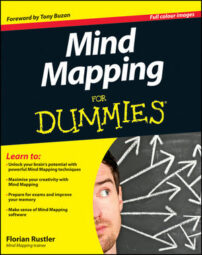Benefits of hand-written or computer-generated mind maps
Mind Mapping as the ‘Swiss army knife’ of working techniques is an extremely versatile tool. It enables you to visualize knowledge and information, particularly in the following areas:
-
Taking notes in lectures, meetings and classes.
-
Structuring and organizing all kinds of content, for example, of manuscripts, presentations and talks.
-
Making notes and records from texts and books.
-
Learning and preparing for exams.
-
Managing projects.
-
Managing knowledge.
To ensure that you can work effectively with the Mind Mapping technique, you have a few simple but crucial rules to bear in mind:
-
Write all information on boughs and branches.
-
Use only one keyword per branch.
-
Include graphic elements like colors, symbols and pictures.
You can generate Mind Maps either with a pen and paper or with software. Both methods have their uses, depending on the objective and application concerned.
Pen and paper are the better choice:
-
When learning and memorizing are involved; for example, while preparing for an exam.
-
If you need a lot of freedom when generating your Mind Map.
Software comes into its own:
-
When you’re dealing with content that frequently changes; for example, in project management.
-
If you want to work on your Mind Map further in other formats.
Tips for using mind mapping quickly and efficiently
For Mind Mapping to quickly become your indispensable tool and for you to work efficiently with the technique, bear the following helpful tips in mind:
-
Start as quickly as possible with small, simple areas of application.
-
Try out the technique on non-critical situations.
-
Create real Mind Maps and not just a mixture of Mind Maps and continuous text.
-
Generate Mind Maps clockwise, starting in the one o’clock position and adding branches to your Mind Map in this direction.
-
Have your basic Mind Mapping working materials to hand, such as different coloured pens and white paper.
-
Make your Mind Maps look as attractive as possible.
-
Decide soon on a software package to avoid duplicated structures.
-
Learn the most important key combinations used in Mind Mapping software.

